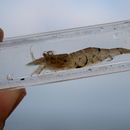Biology
provided by Arkive
The common shrimp feeds on a range of worms, molluscs and crustaceans. The sexes are thought to be separate, and the timing of breeding varies around the country (2). After mating, the female carries the eggs for 3-4 weeks in summer and up to 10 weeks in spring (2). The larvae, known as 'zoeae' are planktonic, and persist for around 5 weeks. Maturity is attained after 1-2 years, and average life span is 3 years (2). This species is predated upon by many species of fish, including cod (Gadus morhua) and whiting (Merlangius merlangus). If attacked, shrimps try to escape by means of rapid flicks of the tail (3).
Conservation
provided by Arkive
No conservation action has been targeted at this common species.
Description
provided by Arkive
The common shrimp, also known as the brown shrimp, is cryptically coloured (3); it is brown and covered with tiny flecks (2). Although most specimens tend to measure between 30 and 50 mm in length, some may grow to 90 mm. The carapace extends between the eyes into a short spine, and the flexible abdomen terminates in a tail fan (known as a 'telson') (2). The word 'shrimp' is Middle English; it may derive from the German word 'schrimpen', which means 'to shrink up', and is applied to small, weak things (4).
Habitat
provided by Arkive
This species occurs from the middle shore down to submerged depths of around 150m; it also extends into estuaries and typically buries into the sand (2).
Range
provided by Arkive
Very common in European waters, and found around the coasts of Britain (2).
Status
provided by Arkive
Common and widespread (2).
Threats
provided by Arkive
This shrimp is fished commercially in some areas, including Morecambe Bay, however it is not currently threatened, and remains a very common species (2).

